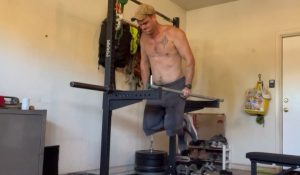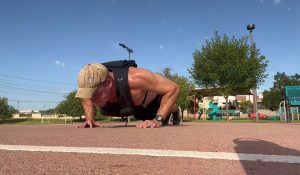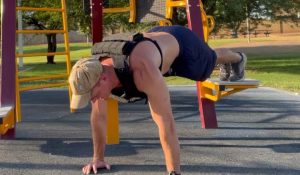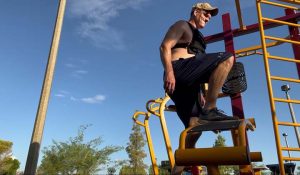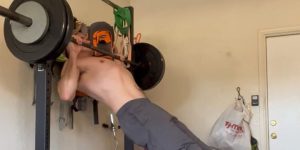Whether we loved them or hated them in gym class, most of us have wondered at some point if it would be possible to get away with doing only push-ups, pull-ups, and squats as a full exercise routine. In our world of high-expense fitness gadgets and complicated programs, this leads us to the obvious question, will it even work?
You can build muscle with just push ups, pull-ups, and squats. This is especially true in the beginning, but properly utilizing progressive overload can yield good results for many years. Deciding whether or not to take a minimalist approach using only push ups, pull-ups, and squats will depend on your goals, level of advancement, and willingness to be consistent.
Let’s explore some of the reasons you might take up this style of bodyweight training, because the true answer to this question, as they say, is nuanced:
Can You Build Muscle With Just Push-Ups, Pull-Ups and Squats?
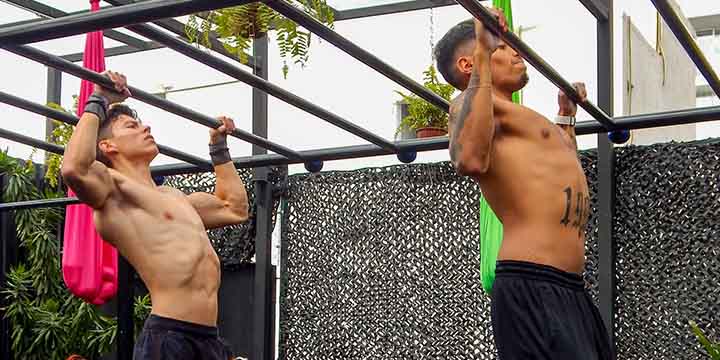
The fitness world is such an interesting place. Often, if you ask 10 “professionals” if something is good or bad, three will say it’s good, three will say it’s bad, and four will say “it depends”. Not very helpful.
Let me ask you this: how many non-muscular folks do you think can complete a sub-1 hour Murph Challenge? I’ll wait.
Here are some guidelines you can expect as to the muscle-building results you’ll get:
If you’re new to the fitness world, then push ups, pull-ups, and squats will absolutely add muscle to your frame, if done properly. The key here will be to properly utilize the principles of strength training: take your sets to within 2-3 reps of failure, and complete around 10 sets of each exercise per week.
This is easy to do with a proper program or can be done in a “micro workout” fashion, where we’re completing work sets here and there to accomplish a total volume goal for the week.
If you’re intermediate (aka you’re no longer making progress workout-to-workout), then you can still build muscle using push ups, pull-ups, and squats if you do so appropriately. At this point, you will likely need external resistance to keep the repetitions on your work sets below 30. You’ll also likely need to bring your weekly volume up between 10 and 20 sets per exercise per week.
Luckily, this is very easy to do by simply adding a weighted vest (20-40lbs for men, or 10-20lbs for women), and holding a plate or kettlebell in the “goblet” position on your squats.
If you’ve been pumping iron for 5+ years already, and you’ve built most of your genetic potential, it’s unlikely that push-ups, pull-ups, and squats will add slabs of muscle to your frame. However, you may experience a general fat-loss effect which will likely make you appear more muscular.
The benefits of utilizing only push-ups, pull-ups, and squats
The workouts are QUICK!
Because these exercises require very little warm-up and don’t require complete rest between sets, you can accumulate a lot of effective volume in just a few minutes. There’s a reason that many calisthenic WODs in CrossFit last 20 minutes or less.
I would argue that 10-15 minutes, three days per week is plenty for most people, depending on their goals. Don’t believe me? I’ll provide a workout below to try.
They are true full-body workouts
The first time you try this style of workout, you’ll likely be extremely sore, well, everywhere!
Fulfilling the basic requirements of push, pull, legs with calisthenic exercises in a single workout assures that almost all muscle groups in the body are being worked in a single session. Just for fun, we thought we’d show this visually:
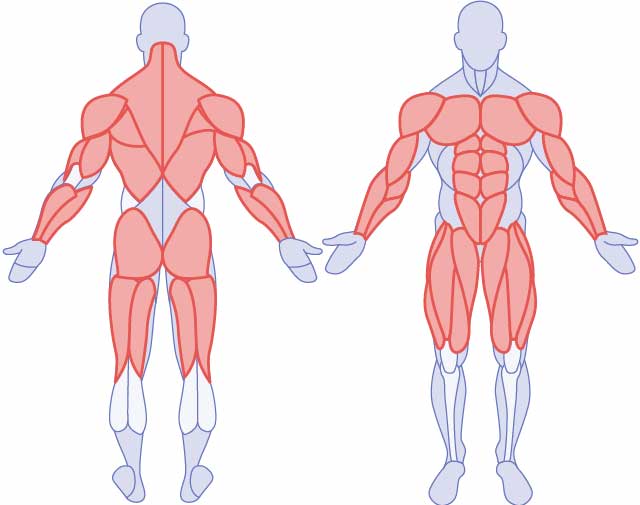
Almost every muscle group in the upper body and lower body is getting hammered with these basic bodyweight workouts: chest, triceps, biceps front / rear shoulders (delts), lats, traps, quads, glutes, hamstrings, and forearms!
Though it’s certainly possible to utilize classic splits, like upper/lower splits with calisthenics, you certainly don’t have to. In fact, these days I would personally prefer to utilize something full-body like heavy, light, medium calisthenics for the time efficiency and practical results.
Though a savvy lifter will find that there is a muscle group or two missing from the picture, it’s about doing the most with the least.
It’s easy to be consistent
Many times people will ask me what is the “key” to fitness, strength, muscle building, or whatever else. The reality is that consistency matters more than anything else.
Elements like programming, exercise selection, auto-regulation, intensity, etc. all take a back seat to consistency. If you don’t do it, it won’t work.
Utilizing a minimum of equipment, for a minimum of time, with a basic exercise selection, 2-4 days per week, for years in a row, will lead to better results than the world’s best program done for 3 weeks and then quitting.
It’s hard to get injured
While I believe that the fear of injury in fitness is (mostly) a boogeyman, it’s extra hard to get injured on exercises like these, as long as you’re not being reckless. It’s likely that you’ll never have to worry about it.
If you do get a slight bit of tendonitis in your elbow from pull-ups, or a bit of patellar tendonitis in your knees, it’s likely that you’ve over-shot your intensity.
Back off for a week or two, eat and sleep right, and these tweaks usually clear up on their own.
Only requires a pull-up bar (or rings)

Anywhere you can do pull-ups, you can use these three exercises. A $35 Iron Gym pull-up bar from Walmart or a $30 set of gymnastic rings will do the trick. Hell, even a sturdy tree branch will work in a pinch.
Pro tip: Make sure it’s a sturdy tree branch. Ask me how I know.
Less thought, more effort
If you’re the type that loves making spreadsheets and using algorithms to determine your working weights for your gym lifts, then you may find this type of exercise boring. I used to be the same way.
In the last few years, I’ve learned to appreciate forms of fitness that require “less thought, more effort.”
Taking a few sets of push-ups and pull-ups to within 2-3 reps of failure isn’t rocket science, and therein lies the beauty. Get your workout done, and move on with your life.
Tips for getting the most out of your bodyweight exercises
Push Up
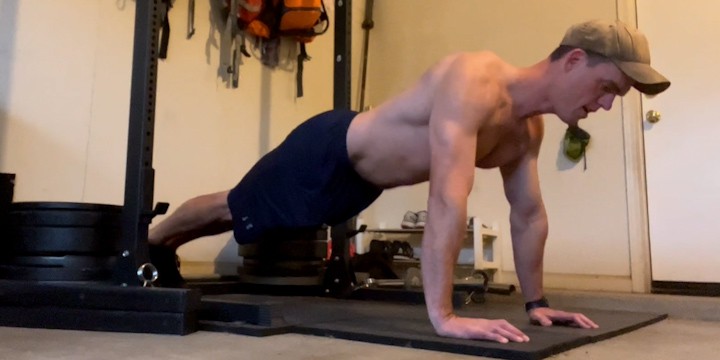
Basic form cues to get the most from your push-up:
- Don’t flare your elbows. If viewed from the top, your upper arm should form a 45-degree angle from your body. You will avoid shoulder injuries and also engage the chest more.
- Let your chest lightly brush the deck, but don’t place your weight all the way onto the floor.
- Almost lock the elbows at the top and spread your shoulder blades. This will engage the serratus anterior, an often neglected muscle groups
If you can’t do a push-up yet, try these variations:
- Push-ups from the knees
- Decline push-ups (hands on a chair)
If you find normal “pumping” reps of push-ups too easy, see our guide on making push-ups more effective (aka “harder”) here.
Pull Ups

Basic form cues to get the most from your pull-up:
- At the bottom, go all the way down until your arms are extended, no bouncing here!
- Chin over the bar is a full rep. If you don’t get your chin over the bar, you have hit muscular failure – stop the set.
If you can’t do a pull-up yet, try these variations:
- Ring rows or inverted rows
- Pull-ups with an exercise band around the bar (loop the other end under a foot or knee)
- See our full article on exercises to help improve pull-up strength
Air Squats

Basic form cues to get the most from your squats:
- Proper depth is when the crease of your hip is below your knee (thighs parallel to the ground or lower). If you can’t achieve this position, it’s likely a form issue. Try bringing the heels closer together or pointing your toes out more.
- On the ascent, consider the rep completed when the legs are straight
- For added difficulty, pause for a one or two count at the bottom
- Don’t pause between reps – air squats are a lightweight exercise that relies on an extended time under tension to get the full effect
- Add a simple weighted implement, like an adjustable dumbbell or weighted vest to your squats if this particular exercise is too easy.
A basic, 10 minute push up, pull-up, squat workout to try
What follows is one of my all-time favorite workouts is this simple 10-minute calisthenic circuit. Ok, it actually takes 10 minutes and 30 seconds. But don’t knock it until you try it:
Set a timer for 10:30 and complete:
- 0:00 – 3:00: Complete 1 minute each of: as many pull-ups as possible, as many push-ups as possible, and as many squats as possible, moving from one exercise to the next. Rest 10-15 seconds as needed, but don’t stop the clock.
- 3:00-6:00: Repeat.
- 6:00-7:30: Complete 30 seconds each of each exercise in the same fashion.
- 7:30-9:00: Repeat.
- 9:00-9:45: Complete 15 seconds each of the three exercises.
- 9:45-10:30: Repeat.
Utilize good form and a full range of motion – the goal isn’t to get as many reps as possible. The goal is to totally exhaust the muscles in a very short period of time.
Forming a sustainable workout program

Using common pull-ups and push-up variations, we can use the workout above to form a basic program:
| Workout A | Workout B |
| Regular Push Ups Pull Ups Air Squats | Diamond Push Ups (hands close together) Chin ups (Palms facing inward) Single leg squats |
A weekly schedule could look like this:
| M | T | W | Th | F | Sa | Su | |
| Week 1 | Workout A | – | Workout B | – | Workout A | – | – |
| Week 2 | Workout B | – | Workout A | – | Workout B | – | – |
If you followed the schedule above, you’d have accumulated 12 weekly sets of each exercise – well within the 10-20 sets per week recommendation. If you wanted to be an overachiever, add a fourth day on Saturday or Sunday and you’d be at 16 weekly sets per exercise.
Workout only a few hours per week
If we were speaking in financial terms, we’d call bodyweight workouts a high ROI investment. That is to say, for a minimal investment of workout time and equipment, we can reap most of the rewards that a much more complex and time-consuming program would afford us.
If you’re looking to build a healthy body or basic muscle mass and are short on time (or just don’t care to become a gym junkie), give this style of workout a try!













